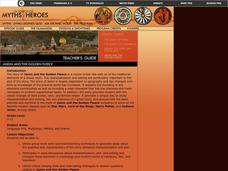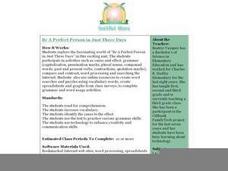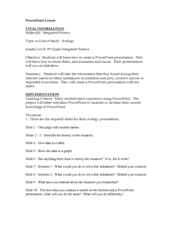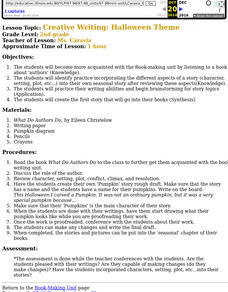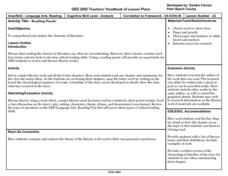Curated OER
Jason and the Golden Fleece
Young scholars read and analyze the classic Greek tale of "Jason and the Golden Fleece." They compare/contrast the story with modern works of literature and films, answer discussion questions, and retell the story in a modern-day setting.
Curated OER
Once Upon a Time
Students use Inspiration to Identify the defining characteristics of Fairy Tales, They create a literary web, study the basic structure of plot, and recognize that themes reoccur across literary works. They complete Once Upon a Time...
Curated OER
Same Old Story
Students relate their favorite childhood stories to their lives today. Through personal interviews, students discover the connections between their favorite stories and their own choices and characters, as well as connections to the...
Curated OER
Literary Analysis - Young Goodman Brown
Why is literary analysis so important? Readers explore writing a literary analysis by reviewing literary elements such as character, metaphor, plot, setting, simile, personification, and style. They read "Young Goodman Brown" by...
Curated OER
The Study of Theme and Figurative Language in Poetry and/or Prose
Identify and analyze the use of figurative language used in select pieces of writing. These pieces of literature will represent at least two pieces by one writer and at least two pieces by different writers. This lesson would be a great...
Novelinks
The Devil’s Arithmetic: Concept Analysis
A helpful guide to Jane Yolen's The Devil's Arithmetic for your literature unit. Use the sections on point-of-view, dramatic irony, and background knowledge, among others, to frame your lessons in an engaging and educational way.
Teaching English
Fairy Tales; Not Just for Kids
"Once upon a time . . ." Language learners examine the key elements of well-known fairy tales and then craft their own.
Curated OER
Promoting the South Carolina Junior Book Award Nominees
Sixth graders recongize and analyze different components of a piece of literature. They must also practice their oral communcation skills by reading a book to an audience.
Curated OER
"Theseus and the Minotaur"
Students analyze the features of myths and legends. They read the myths "Theseus and the Minotaur" and "Orpheus and Eurydice," identify the myth story elements, evaluate each story for the overall theme, describe the characters, and...
Curated OER
Exploring the Mystery Genre
Students determine the story elements of typical mystery stories including characters and plot structure. They look at vocabulary that is common to mystery stories before reading and responding to mystery chapter books. Working in guided...
Curated OER
Computer Mysteries
Who has been messing with my trampoline? Young writers choose local events as the basis for their own “Who Did It?” mystery. They then devise a plot, problem, and cast of characters and write an introduction explaining the problem and...
Curated OER
Bridge to Terabithia
Students read Katherine Paterson's book, A Bridge to Terabithia, and select small groups to complete a project based on a chapter of the book. They create a story web for the chapter, summarize it, design a brochure or advertisement,...
Curated OER
Multicultural Fairy Tales
Third graders explore the elements of a story using fairy tales from all over the world. They compare and contrast story elements, key ideas and concepts found in a variety of texts from around the world.
Curated OER
Language Arts: A "Perfect" Lesson
Pupils read "Be A Perfect Person in Just three days," and participate in a host of activities. Connected to technology, they use online sources to create word searches and puzzles from vocabulary words. In addition, students create...
Curated OER
Humorous Story Featuring Clowns
Middle schoolers write stories that feature funny clowns. In this creative writing instructional activity, students follow the outline for a story in order to write their own humorous story set at a circus.
Curated OER
Ecology
Students personify ecology vocabulary and write a one-act play using their knowledge of ecology as the basis for characters, conflict, setting and plot.
Curated OER
Story Writing
Students work in groups to create a story that will be presented to the class. In this story writing lesson, students complete a project planning sheet, work together to create a story that includes a hero and at least two other...
Curated OER
Creative Writing: Halloween Theme
Second graders are read a book about different authors. They identify the parts of a story such as plot and setting. They brainstorm topics for their own paper and begin the writing process. They create a final copy of their story about...
Curated OER
Tales From Around the World
Students read stories. In this culture lesson plan, students read stories from different regions around the world. Students look for each region on the map and listen for interesting cultural details in the story. Students then discuss...
Curated OER
Enrichment Activities - "Mrs. Frisby and the Rats of NIMH"
Fifth graders read the novel "Mrs. Frisby and the Rats of NIMH." They discuss the various characters in the book, and the different types of conflict that take place within the book. They also research owls and rats to make comparisons...
Curated OER
Establishing a Point of View in Narratives
Fourth graders investigate the concept and take the opportunity to both identify and to construct point of view in narratives. Additionally, 4th graders practice identifying and sequencing main events.
Curated OER
Retelling Nursery Rhymes
Fourth graders explore language arts by reciting a famous nursery rhyme to their classroom. In this oral storytelling lesson, 4th graders read the story "The Three Little Pigs" and identify the characters, setting and story. Students...
Curated OER
Analyzing Story Structure
Young scholars explore language arts by completing a graphic organizer in class. In this story structure lesson, students read the poem "Sick" by Shel Silverstein and discuss the different elements in the piece which make it an...
Curated OER
Reading Puzzle
Twelfth graders examine the elements of literature. They each read a chapter of a novel, sequentially list the main ideas, present a summary of the chapter to the class, sequence the events, and review the novel by summarizing the timeline.
